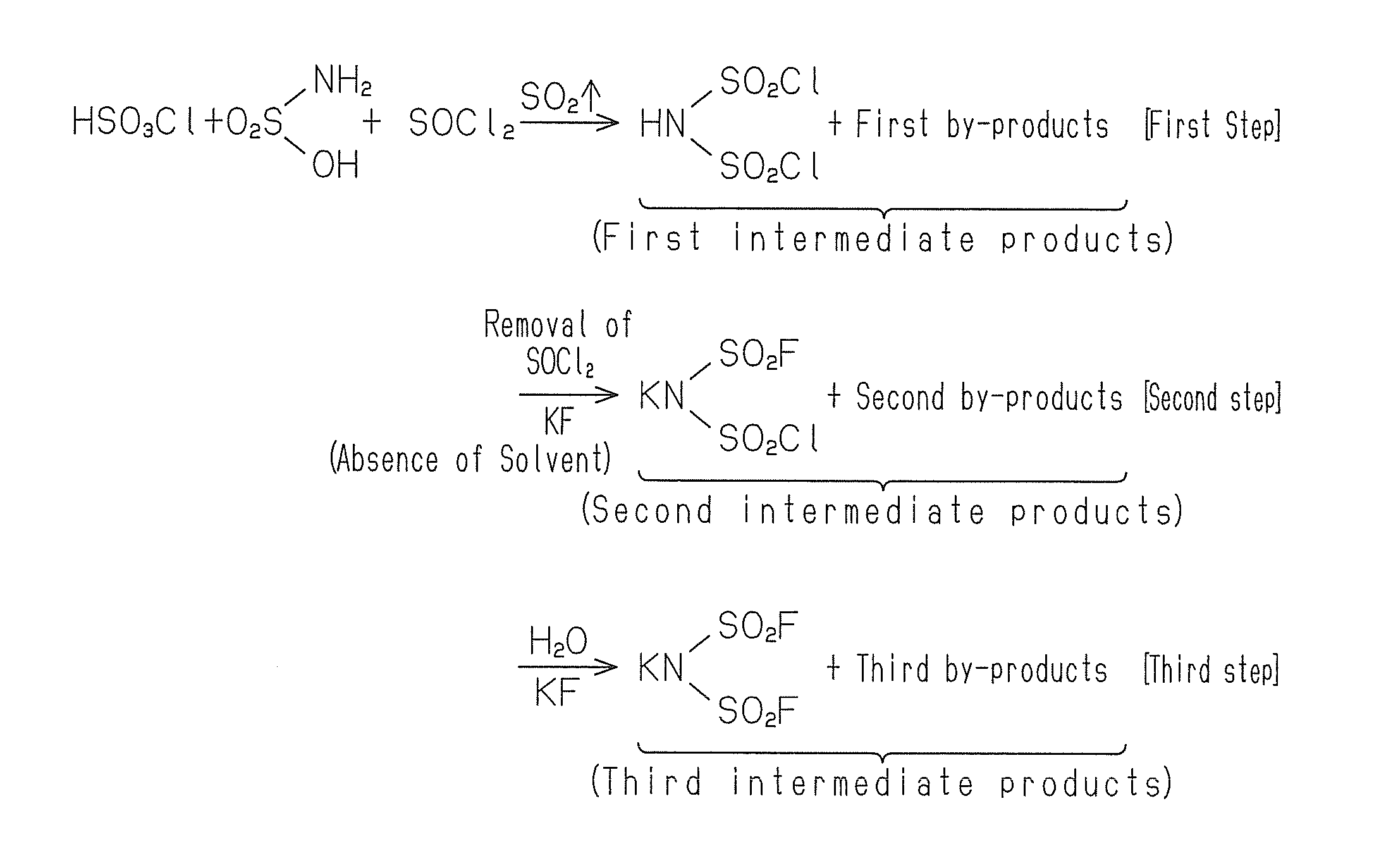Method for producing imide salt
a technology of imide salt and imide salt, which is applied in the direction of nitrogen compounds, chemistry apparatus and processes, inorganic chemistry, etc., can solve the problems of slow reaction, inability to increase the concentration of alkali metal fluoride mf, and inability to increase the rate of reaction, so as to reduce the amount of unreacted sulphamic acid and increase the yield
- Summary
- Abstract
- Description
- Claims
- Application Information
AI Technical Summary
Benefits of technology
Problems solved by technology
Method used
Image
Examples
example 1
(First Step)
[0033]Sulphamic acid, chlorosulphonic acid and thionyl chloride are mixed in an inert atmosphere at a molar ratio of 1.0:1.0:2.4 and heated under reflux. The temperature is 130° C.
[0034]The reaction of sulphamic acid with chlorosulphonic acid and thionyl chloride gives HN(SO2Cl)2. This reaction also provides by-products including sulphur dioxide, sulphuric acid and hydrochloric acid. Sulphur dioxide is generated from the reaction of thionyl chloride with sulphamic acid. Thus generation of sulphur dioxide indicates continuation of the reaction. Thus the heating is continued until generation of sulphur dioxide is ceased.
[0035]After completion of the reaction, a calcium chloride tube is attached to a vapour outlet of the reaction system with care so that moisture is not introduced into the reaction system, and the whole reaction system is cooled. Thereby hydrolysis of HN(SO2Cl)2 due to introduction of moisture is prevented.
(Second Step)
[0036]The first intermediate products ...
example 2
[0044]The method for producing KN(SO2F)2 from sulphamic acid, fluorosulphonic acid and thionyl chloride, which are starting materials, is described.
[0045]In Example 2, fluorosulphonic acid was used in place of chlorosulphonic acid in Example 1.
[0046]In the first step, sulphamic acid, fluorosulphonic acid and thionyl chloride are subjected to reaction which gives HN(SO2Cl)(SO2F). Namely, the substance which is produced during the process of the second step in Example 1 is obtained in this step. This may be due to sulphonation reaction with fluorosulphonic acid of an intermediate obtained by substitution of the OH group in sulphamic acid with chlorine.
[0047]In the second step, to the first intermediate products obtained in the first step from which excess thionyl chloride has been removed is added potassium fluoride (KF) to allow the reaction to proceed. Thereby almost the whole amount of by-products, namely sulphuric acid and hydrochloric acid is converted to salts.
[0048]In the third...
PUM
 Login to View More
Login to View More Abstract
Description
Claims
Application Information
 Login to View More
Login to View More - R&D
- Intellectual Property
- Life Sciences
- Materials
- Tech Scout
- Unparalleled Data Quality
- Higher Quality Content
- 60% Fewer Hallucinations
Browse by: Latest US Patents, China's latest patents, Technical Efficacy Thesaurus, Application Domain, Technology Topic, Popular Technical Reports.
© 2025 PatSnap. All rights reserved.Legal|Privacy policy|Modern Slavery Act Transparency Statement|Sitemap|About US| Contact US: help@patsnap.com


